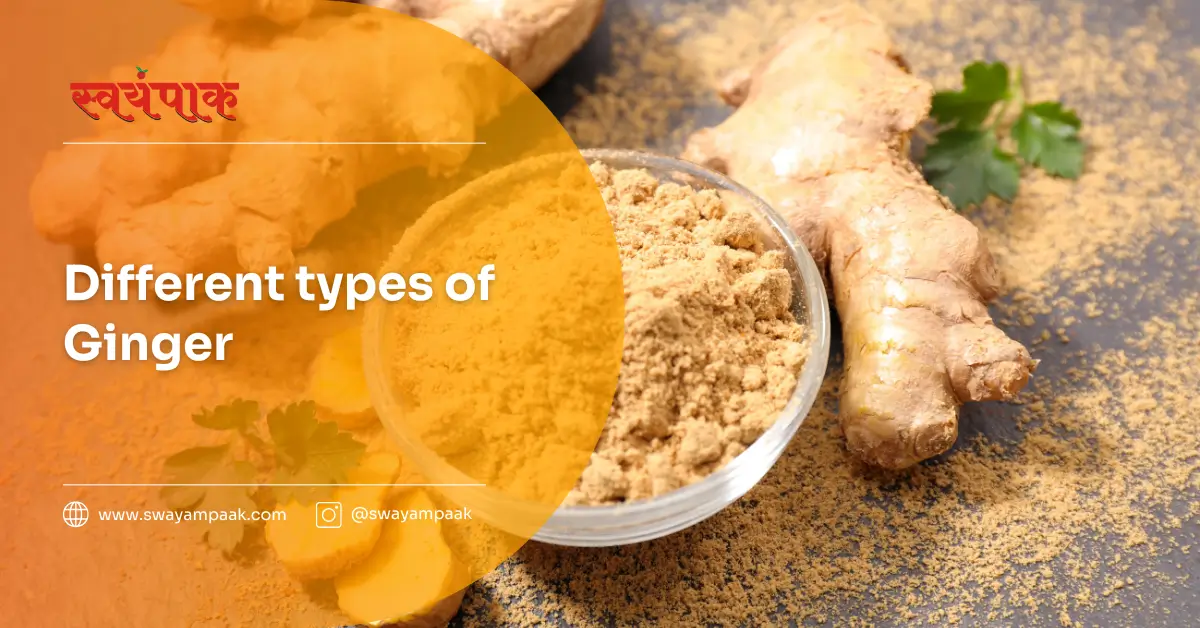Ginger is a vital ingredient for many people, adding warmth and flavour to tea and meals daily, along with its numerous health benefits.
Since ancient times, different types of ginger, ranging from common ginger to peacock ginger, have been widely used in both medicine and cooking. Its unique warm and spicy flavour, along with its inviting scent, makes it a popular ingredient in recipes around the globe.
Beyond its culinary applications, ginger has been valued for its potential health benefits, which include reducing inflammation, promoting better digestion, and alleviating nausea. In this article, I will discuss the different types of ginger found around the world, as well as its culinary and health uses.
Different types of ginger
Common ginger (Zingiber officinale)
Common ginger, scientifically known as Zingiber officinale is a tropical plant that is well-known for its fragrant rhizome. This Southeast Asian native perennial plant has been utilised for generations in medicine and cooking. Worldwide, the common ginger is used in many different cuisines due to its strong flavour and many health advantages. From European sweets to Asian stir-fries, common ginger gives food a certain depth and warmth.
Uses
Cooking: A versatile spice, common ginger is utilised in many different cuisines around the world. Its unique flavour gives food depth and cosiness. It is an essential component of European baked products, Indian curries, and Asian stir-fries. It can be steeped into a calming tea, candied into a sweet treat, or freshly grated into a stir-fry.
Medical: Traditional medicine has traditionally made use of common ginger. It is frequently used to treat gastrointestinal problems such as bloating, indigestion, and nausea. For generations, people have used it as a medicine because of its ability to calm an upset stomach.
Galangal (Alpinia Galanga)
Galangal, a tropical perennial plant belonging to the ginger family, is often referred to as Siamese ginger or greater galangal. A common spice in Southeast Asian cooking is its fragrant rhizome, which resembles ginger but has a stronger flavour. It gives curries, soups, and stir-fries a distinct citrussy, peppery, and somewhat piney flavour. Galangal has been used in ancient medical systems such as Ayurveda and ancient Chinese medicine because of its possible health advantages.
Uses
Cooking: A key ingredient in Southeast Asian cooking, especially Thai and Indonesian fare. It gives stir-fries, soups, and curries a distinctively peppery and citrussy flavour.
Tom Yam Soup and Massaman curry are Thai dishes that include galangal.
Medicinal: Traditional medicine has utilised galangal to treat a range of conditions, including inflammation, respiratory infections, and digestive issues. Some of the medical applications of galangal are:
- Indigestion treatment: Galangal is thought to help reduce bloating and indigestion. Traditional medicine frequently uses it to treat certain ailments.
- Immunity-boosting: Galangal is believed to strengthen the immune system, increasing its resistance to illness.
Inflammation reduction: Galangal’s anti-inflammatory qualities may aid in lowering discomfort and oedema. It is occasionally used to treat inflammatory diseases like arthritis.
Fingerroot (Boesenbergia pandurate)
The tropical plant Fingerroot, also known as Chinese ginger or temu kunci, has a distinctive finger-shaped rhizome. It is often used in Southeast Asian cooking to give food a unique flavour and scent. fingerroot has long been used to treat a variety of illnesses with herbal remedies. Fingerroot roots contains bioactive compounds with anti-inflammatory, antioxidant, and anticancer properties that may positively impact health.
Uses
Cooking: In Southeast Asian cooking, fingerroot is a multipurpose ingredient. Numerous meals gain depth and richness from its distinct flavour and scent. It is frequently used in marinades, stir-fries, soups, and curries.
Medicinal: Traditional medicine has traditionally made use of fingerroot. It is thought to offer several health advantages, such as:
- Digestive health: Indigestion, gas, and bloating are among the digestive issues that can be treated by the use of fingerroot ginger. It is also thought to aid with appetite stimulation.
- Anti-inflammation properties: Fingerroot includes substances that reduce inflammation. Because of this, it may be used to treat ailments including gout and arthritis.
- Antioxidant qualities: Fingerroot contains a lot of antioxidants that can fight off cell damage.
- Other possible benefits: Fingerroot is thought to have additional health advantages, including strengthening the immune system, enhancing blood flow, and lessening discomfort.
White ginger (Hedychium coronarium)
white ginger is a lovely and fragrant flowering plant. It bears big, eye-catching white blooms that smell sweet and spicy and resemble butterflies. Although its roots are edible and have therapeutic qualities, its main uses are as cut flowers and as a decorative in gardens.
Uses
Aromatherapy: To encourage relaxation and lessen stress, white ginger essential oil can be used.
Skincare: White ginger can help calm skin and lessen irritation when added to skincare products.
Ornamental: White ginger is cultivated mainly for its aromatic and lovely blooms. The blossoms can be dried and used to make potpourri, and they are frequently used in floral arrangements. In tropical gardens, white ginger is a popular choice since it may provide a touch of elegance and scent.
Cooking: Use to make it into a calming tea, add in stir-fries, and add in juices or smoothies.
Medical: Its anti-inflammatory qualities may reduce the symptoms of diseases like irritable bowel syndrome, and its natural enzymes can aid in better digestion.
Hidden ginger (Curcuma Petiolata)
Hidden ginger, also known as Siam Tulip or Queen Lily, is a beautiful tropical ornamental plant. Even though it is not edible, it belongs to the ginger family. Its lovely, vibrant bracts, which mimic petals, are its distinctive feature. the actual blooms are tiny and concealed inside.
Hidden ginger enjoys partial shade and grows well in warm, humid conditions. Its striking blossoms and colourful foliage give gardens a hint of exotic appeal.
Uses
Ornamental Uses: Container gardens, mixed beds, and gorgeous borders can all be made with hidden ginger. It is ideal for establishing a tropical haven in the garden because of its vibrant bracts and luxuriant leaves.
Peacock ginger (Kaempferia)
Peacock ginger is a genus of flowering plants that are indigenous to tropical Asia. The main reason these plants are cultivated is for their beautiful foliage, which frequently has eye-catching hues and patterns.
Usually round or oval, the leaves might have striking golden, purple, or silver patterning over green backgrounds. Some types even have completely green leaves. While peacock gingers have fragrant flowers, their distinctive and beautiful foliage is what truly sets them apart.
Uses
Ornamental: Because of their distinctive blossoms and lovely foliage, peacock gingers are a common choice for ornamental plants. They are frequently cultivated as houseplants and in gardens.
Medicinal: Strong anti-inflammatory and antioxidant chemicals are present in peacock ginger.. peacock ginger can help to reduce inflammation, which is involved in a variety of health diseases like arthritis, asthma, and heart disease.
Cooking: Peacock ginger roots are occasionally used in cooking, but they are less common than other types of ginger.
It can be used to provide a unique flavour layer to a variety of meals, such as marinades, stir-fries, and curries.
Conclusion
Ginger is more than just a tasty and adaptable spice. This amazing plant offers a world of flavour and possible health advantages, ranging from common ginger to peacock ginger.
The next time you’re at the grocery store, have a look at the ginger section. The variety and intriguing gastronomic and fitness opportunities that lie ahead may surprise you! Remember that gingers like peacock and hidden ginger add beauty and fascination to the garden, even outside the kitchen.
So why not add this intriguing plant family to your life and learn all the ways ginger can improve it?


